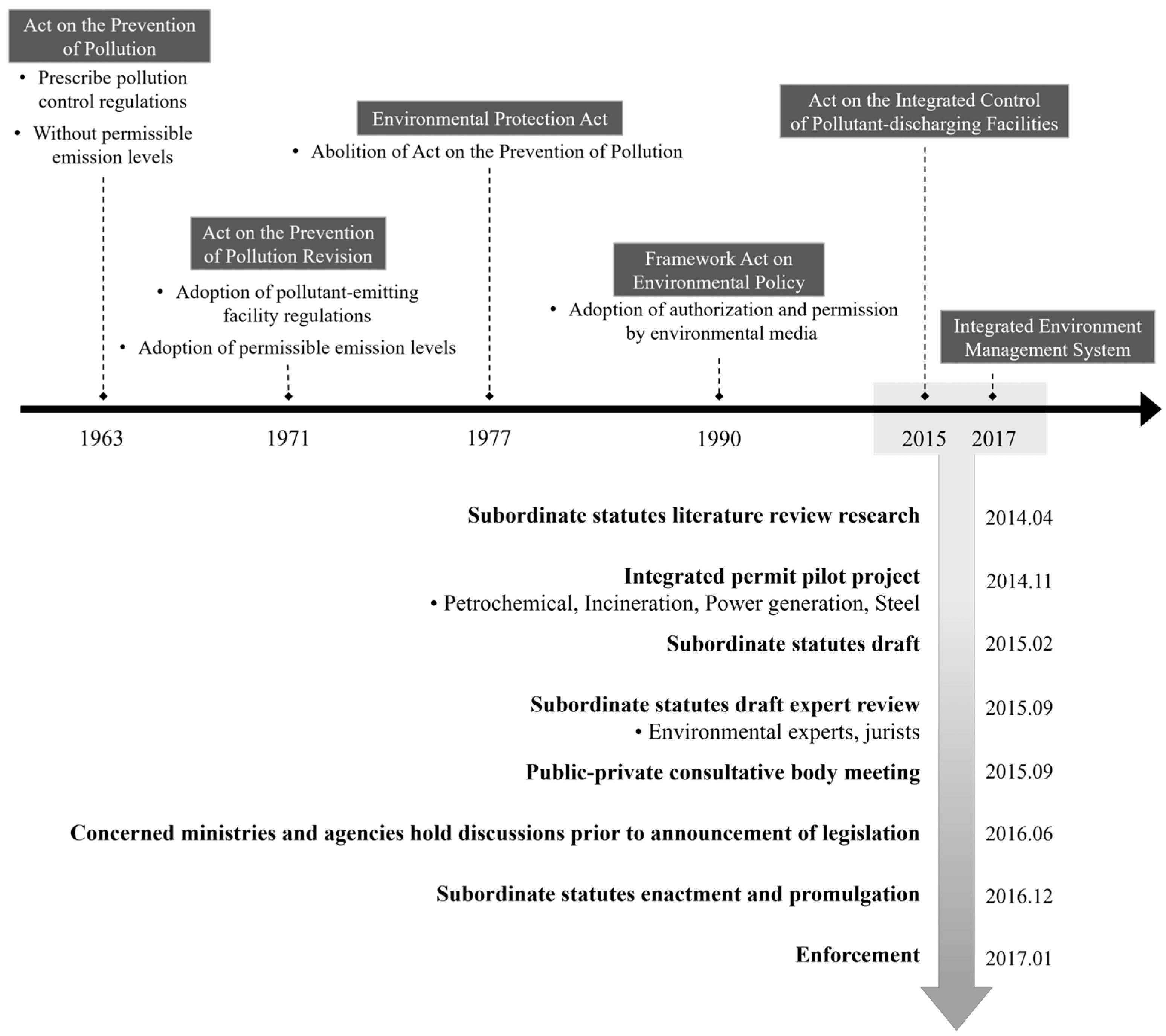Implementation of Integrated Environmental Management and Its Specialized Engineering Education in Korea: A Case Study
[ad_1]
1. Introduction
Therefore, the aims of this study are to examine the history and strategy of establishing an IEM policy in Korea and review essential technologies, such as emission impact analysis and Best Available Technologies (BATs), that are applied in IEM in Korea. In addition, the specialized training program for IEM in Korea and the applications of the educational system, industry–academia cooperation, and research at University K, selected as representative examples, are discussed.
2. Materials and Methods
To establish these sustainability policies, programs aimed to provide IEM expertise are being developed. For solutions with engineering input, the Korean Ministry of Environment has researched education programs in cooperation with various organizations. We analyzed the human resources training programs for the sustainability market. University K, which was selected as a specialized training institution for IEM in 2020 with the support of the Ministry of Environment of Korea, is the representative case study because it has been a leader in convergence education since 2004; it established the first interdisciplinary convergence departments in Korea and has been ranked at the top since the inception of the professional IEM training program. The case study analyzes whether learners who completed the program achieved the curriculum objectives, including specialized knowledge and common skills such as writing an IEM plan and performing emission impact analysis. In addition to the educational program, an industrial cooperative project and related research were investigated. The main aspects of this study are as follows:
-
Historical Background: Summary of the overall flow of the development of IEM in Korea.
-
Composition of policy: Operational techniques and systems of IEM.
-
The major technological elements of the policy include emission impact analysis, permit emission standards, and BATs.
-
Specialized educational project: Training program to reinforce expert capacity for IEM.
3. Results
3.1. Integrated Environmental Management in Korea
3.1.1. Historical Background
3.1.2. Organization and Framework of Integrated Environmental Management
3.1.3. Major Techniques in Integrated Environmental Management
IEM is an advanced system aimed at resolving the problems of the existing permit system and having various scientific and technical differences from the existing method. The main technical components of IEM are as follows.
3.1.4. Educational Project for Training of Professionals on Integrated Environmental Management
It is important to create professional personnel who can understand the existing integrated environmental management system and provide urgent, up-to-date information. The Ministry of Environment selects and invests in excellent higher education institutions in Korea through the IEM educational program to foster experts in IEM. In particular, universities specialize in educating these engineering experts so they may be optimized for developing and researching human resource education programs. The five universities selected through strict evaluation are supported by a total budget of more than USD 7 million (KRW 9 billion) and produce approximately 100 people with specialized training in IEM every year. Each university operates a specialized graduate school aimed at improving the technical skills of practical-oriented professionals in IEM through the systematic development of educational programs and research in connection with industries. The curriculum includes preparing an IEM plan, which is essential for applying for integrated permits, and major core common subjects, including the EIA. Additionally, each university conducts a convergence course between related majors and forms a joint industrial practice (consortium) curriculum.
3.2. Case Study: IEM Educational Program at University K, Seoul
A case study was conducted to better understand the programs of graduate schools specializing in integrated pollution prevention and control as promoted by the Ministry of Environment in Korea. University K, which was evaluated as the best case among the institutions selected for such programs, was selected and investigated as an expert training program for IEM. University K developed a human resources training program as a way to address integrated environmental management problems; analysis of this case can be useful for future applications in the field of sustainability.
3.2.1. Curriculum
With the implementation of IEM policies by industries, the need to cultivate professionals who can comprehensively understand pollutant tracking has increased. Therefore, the IMG Educational Program conducted by University K has organized and operated a professional curriculum to train experts. The curriculum consisted of subjects for the preparation of an Integrated Environmental Management plan, emission impact analysis, calculation of mass balance, and understanding of the process, including emission and prevention facilities.
3.2.2. Industrial Cooperative Project
Close cooperation with industries is essential to improving the employment competitiveness of students who have completed the program and meet the requirements for education in the field. University K formed a consortium with major industries in the IEM field to provide students with education at industrial sites. The IEM Educational Program has established industry–academia partnerships with Integrated Environmental Management consulting industries, pollutant emission sources, governments, and numerous research institutes. Through these connections, opinions from various field experts are collected, which contribute to the development of the program and curriculum.
3.2.3. Research
Students participating in the program undertake various educational projects, including in-depth research, as described above. In other words, this program aims to educate and train experts with a wide range of relevant theories and practical experience in IEM to meet the demands of the actual field.
4. Conclusions
This study examined and discussed the introduction and development of IEM policy in Korea, along with its operational system and established technologies. Following the introduction of IEM, the environmental management approach in Korea shifted towards pollutant source management. This has led to positive outcomes such as the establishment of a scientific basis for emission regulations, self-management by businesses, and gradual reinforcement of emission regulations through periodic permit reviews. In addition, the introduction of emission impact analysis and BAT criteria, the main technical components of IEM, provides a scientific basis for system operation and addressed the lack of expertise in managing businesses based on existing media-specific approaches.
The specialization of the personnel in charge is essential to increase the completeness and implementation of Integrated Environmental Management. Specialized education programs to train experts in the field of Integrated Environmental are led by the Korean government. To study the educational program model, University K, the best of five institutions selected by the Ministry of Environment, was chosen for analysis. As investigated in this study, the expertise needed in the current sustainability market must include diverse experiences and theoretical knowledge. In order to analyze the goals of the integrated environmental management system, well-constructed educational cases were selected and analyzed. Through regular surveys and tracking, engineering students who completed the above education program were confirmed to meet the qualifications for sustainability development challenges. The seminars, field practice, and research activities for specialized subjects in the program were carried out through close cooperation with various related institutions, and the quality of education was greatly improved. However, the period in which the system was implemented was relatively short, so related information is limited. Therefore, it is important to collect data from the beginning and accumulate feedback on any problems. Also, because policies are continuously expanding, research in new areas is also necessary. This educational model can provide guidelines for countries preparing to introduce Integrated Environmental Management in the future. In particular, the goals and planned composition proposed in this program are believed to be of great help in the design and strategic development of the curriculum for fostering expertise.
Author Contributions
Conceptualization, Y.S. and K.-H.H.; methodology, M.-S.K.; software, D.-S.P.; validation, K.-H.H., Y.S. and D.-S.P.; formal analysis, D.-S.P.; investigation, M.-S.K.; resources, C.-B.C.; data curation, D.-S.P.; writing—original draft preparation, D.-S.P.; writing—review and editing, K.-H.H.; visualization, D.-S.P.; supervision, K.-H.H.; project administration, Y.S.; funding acquisition, Y.S. All authors have read and agreed to the published version of the manuscript.
Funding
This work was financially supported by the Korean Ministry of Environment (MOE) Graduate School specializing in Integrated Pollution Prevention and Control Project.
Institutional Review Board Statement
Not applicable.
Informed Consent Statement
Not applicable.
Data Availability Statement
Data is contained within the article.
Acknowledgments
We want to express our sincere gratitude to the anonymous reviewers and editors for their efforts in improving the paper.
Conflicts of Interest
The authors declare no conflicts of interest.
References
- Park, J.H.; Kim, Y.S.; Lee, W.S. Significance and Development of the Integrated Environment Management System Implementation. J. Korean Soc. Water Environ. 2016, 32, 318–324. [Google Scholar] [CrossRef]
- Environmental Permitting Guidance: The Large Combustion Plants Directive. Available online: https://www.gov.uk/government/publications/environmental-permitting-guidance-the-large-combustion-plants-directive (accessed on 26 December 2023).
- Korean Society on Water Environment; National Institute of Environmental Research. Enhanced Integration Prepared Based Integrated Environmental Management and Environmental Management of Water; National Institute of Environmental Research: Incheon, Republic of Korea, 2013. [Google Scholar]
- Han, D.H.; Yang, I.J.; Kang, P.G.; Kim, E.S. Policy Research Direction for Integrated Environment Management. Proc. Korea Air Pollut. Res. Assoc. Conf. 2019, 62, 49. [Google Scholar]
- Shin, Y.S. Review on the Current Status of Integrated Multimedia Risk Assessment for Implementing Integrated Environmental Management in Korea. Environ. Law Policy 2009, 2, 145–166. [Google Scholar]
- Seo, J.H.; Hwang, H.-J.; Khan, J.; Lee, S.; Kim, Y. The Present Status and Improvement of Air Quality Assessment Methodology for Integrated Environmental Permission System. J. Korean Soc. Atmos. Environ. 2021, 37, 523–535. [Google Scholar] [CrossRef]
- Kim, B.G. Development of the Integrated Environmental Management Policy. Proc. Korea Air Pollut. Res. Assoc. Conf. 2019, 62, 47. [Google Scholar]
- Kim, E.; Kim, G.; Seo, K.; Khan, J.-B.; Seok, H.; Kim, Y.; Kang, P.-G. Introduction on Best Available Techniques Reference Document for the Display Manufacturing Industry in Korea. Kihm 2019, 7, 42–49. [Google Scholar] [CrossRef]
- Jeong, H.-Y. EU Envioronmental Policy and Their Impact on Korean Industries. J. Contemp. Eur. Stud. 2007, 24, 263–302. [Google Scholar] [CrossRef]
- Lee, H.J. The Expected Roles of Environmental Consulting Company for the Integrated Environment Permitting Scheme. Proc. Korea Air Pollut. Res. Assoc. Conf. 2019, 64, 48. [Google Scholar]
- Seo, K.; Kim, E.; Kim, G.; Khan, J.; Hong, S.; Kang, P. Understanding and Improvement of the K-BREF (Korea BAT Reference Documents) for the Corrugated Cardboard Manufacturing Industry. J. Environ. Sci. Int. 2020, 29, 559–573. [Google Scholar] [CrossRef]
- Park, J.-H.; Seok, H.-J.; Kang, P.-G.; Ahn, H. Utilization of an Information System for the Efficient Implementation of the Integrated Environmental Permit System in South Korea. Sustainability 2023, 15, 16512. [Google Scholar] [CrossRef]
- Zhang, Y.; Chen, X. Empirical Analysis of University–Industry Collaboration in Postgraduate Education: A Case Study of Chinese Universities of Applied Sciences. Sustainability 2023, 15, 6252. [Google Scholar] [CrossRef]
- Song, J.H.; Jang, H.S. Problems and Discussions on the Korean Integrated Pollution Prevention and Management Law Cases in Air Pollution and Odor. Proc. Korea Air Pollut. Res. Assoc. Conf. 2019, 62, 49. [Google Scholar]
- Framework Act on Environmental Policy. Available online: https://elaw.klri.re.kr/kor_service/lawView.do?hseq=60971&lang=ENG (accessed on 26 December 2023).
- Park, J.H.; Shin, S.J.; Lee, D.G. Enhancing the Applicability and Improvement Direction of Integrated Environmental Permit System. J. Korean Soc. Water Environ. 2018, 34, 339–345. [Google Scholar] [CrossRef]
- Lee, J.H. Integrated Environmental Management and Environmental Impact Assessment. J. Korean Cadastre Inf. Assoc. 2018, 20, 89–103. [Google Scholar] [CrossRef]
- Clean Air Conservation Act. Available online: https://elaw.klri.re.kr/kor_service/lawView.do?hseq=57423&lang=ENG (accessed on 26 December 2023).
- Water Environment Conservation Act. Available online: https://elaw.klri.re.kr/kor_service/lawView.do?hseq=54838&lang=ENG (accessed on 26 December 2023).
- Beak, S.J.; Lee, S.W.; Yun, Y.B.; Kim, D.C. The BAT Reference Document for Enforcing the Integrated Environmental Management System. Proc. Korea Air Pollut. Res. Assoc. Conf. 2014, 57, 85. [Google Scholar]
- Kim, D.Y.; Cho, Y.M.; Choi, M.A.; Jun, S.Y.; Hong, L.S. A Policy Implication of Integrated Pollution Prevention and Control Program in Gyeonggi-Do; Policy Research; Gyeonggi Research Institute: Suwon, Republic of Korea, 2014; pp. 1–53. [Google Scholar]
- Lee, S.K. Conceptual Framework of Integrated Environmental Management. Korean Soc. Public Adm. 2004, 15, 313–332. [Google Scholar]
- Act on the Integrated Control of Pollutant-Discharging Facilities. Available online: https://elaw.klri.re.kr/kor_service/lawView.do?hseq=55955&lang=ENG (accessed on 26 December 2023).
- Kim, D. Research on Improvement of Permission System under Act on the Integrated Control of Pollutant-Discharging Facilities. Environ. Law Rev. 2020, 42, 57–87. [Google Scholar] [CrossRef]
- Enforcement Decree of the Act on the Integrated Control of Pollutant-Discharging Facilities. Available online: https://elaw.klri.re.kr/eng_mobile/viewer.do?hseq=55955&type=part&key=39 (accessed on 26 December 2023).
- Kim, J.H.; Jeong, S.Y.; Na, M.H.; Choi, J.H.; Im, C.I. A Case Study and Review of Emission Impact Analysis for Establishing Integrated Environmental Management Permit Emission for Air Pollutants-Emitting Facilities. In Proceedings of the Korea Environmental Policy and Administration Society Conference, Gwangju, Republic of Korea, 23 June 2017; pp. 9–23. [Google Scholar]
- Seok, H.-J.; Kahn, J.-B.; Kim, Y.-L.; Seo, J.-W.; Hong, S.-Y.; Kim, H.-J. Discharge Impact Analysis of Air Pollutants for Integrated Environmental Management. J. Environ. Anal. Health Toxicol. 2020, 23, 240–247. [Google Scholar] [CrossRef]
- Kim, J.H.; Ha, T.Y.; Na, M.H.; Lee, J.H. A Case Study on Integration Permitting of Power Generation Sector by Implementation of Integrated Environmental Management System. Korean Policy Sci. Rev. 2018, 27–30. [Google Scholar] [CrossRef]
- Guem, H.S. Introduction of an Integrated Approach into the Environmental Permitting and Management System. Proc. Korea Air Pollut. Res. Assoc. Conf. 2014, 57, 85. [Google Scholar]
- National Institute of Environmental Research. Plan for Integrated Environmental Control Guidelines; Ministry of Environment in Korea: Sejong, Republic of Korea, 2020. [Google Scholar]
- National Institute of Environmental Research. Best Available Techniques Reference of Korea—Plastic Product Manufacturing Industry; Ministry of Environment in Korea: Sejong, Republic of Korea, 2020. [Google Scholar]
- European Union (EU). Directive 2010/75/EU of the European Parliament and of the Council of 24 November 2010 on Industrial Emissions; Integrated Pollution Prevention and Control: Dresden, Germany, 2010. [Google Scholar]
- National Institute of Environmental Research. Best Available Techniques Reference of Korea—Steel Manufacturing Industry; Ministry of Environment in Korea: Sejong, Republic of Korea, 2017. [Google Scholar]
- Baek, J.; Cho, K. A Study on the Factors Influencing Regulatory Awareness: A Focus on the Sites Subject to the First Year of the Integrated Environmental Management System. Kpsr 2020, 24, 105–129. [Google Scholar] [CrossRef]
- ISO 14040:2006; Environmental Management—Life Cycle Assessment—Principles and Framework. ISO: Geneva, Switzerland, 2006.
- ISO 14044:2006; Environmental Management—Life Cycle Assessment—Requirements and Guidelines. ISO: Geneva, Switzerland, 2006.
- ISO/TS 14072:2014; Environmental Management—Life Cycle Assessment—Requirements and Guidelines for Organizational Life Cycle Assessment. ISO: Geneva, Switzerland, 2014.
Figure 1.
History of environmental management and related policies in Korea.
Figure 1.
History of environmental management and related policies in Korea.
Figure 2.
Integrated environmental management in Korea.
Figure 2.
Integrated environmental management in Korea.
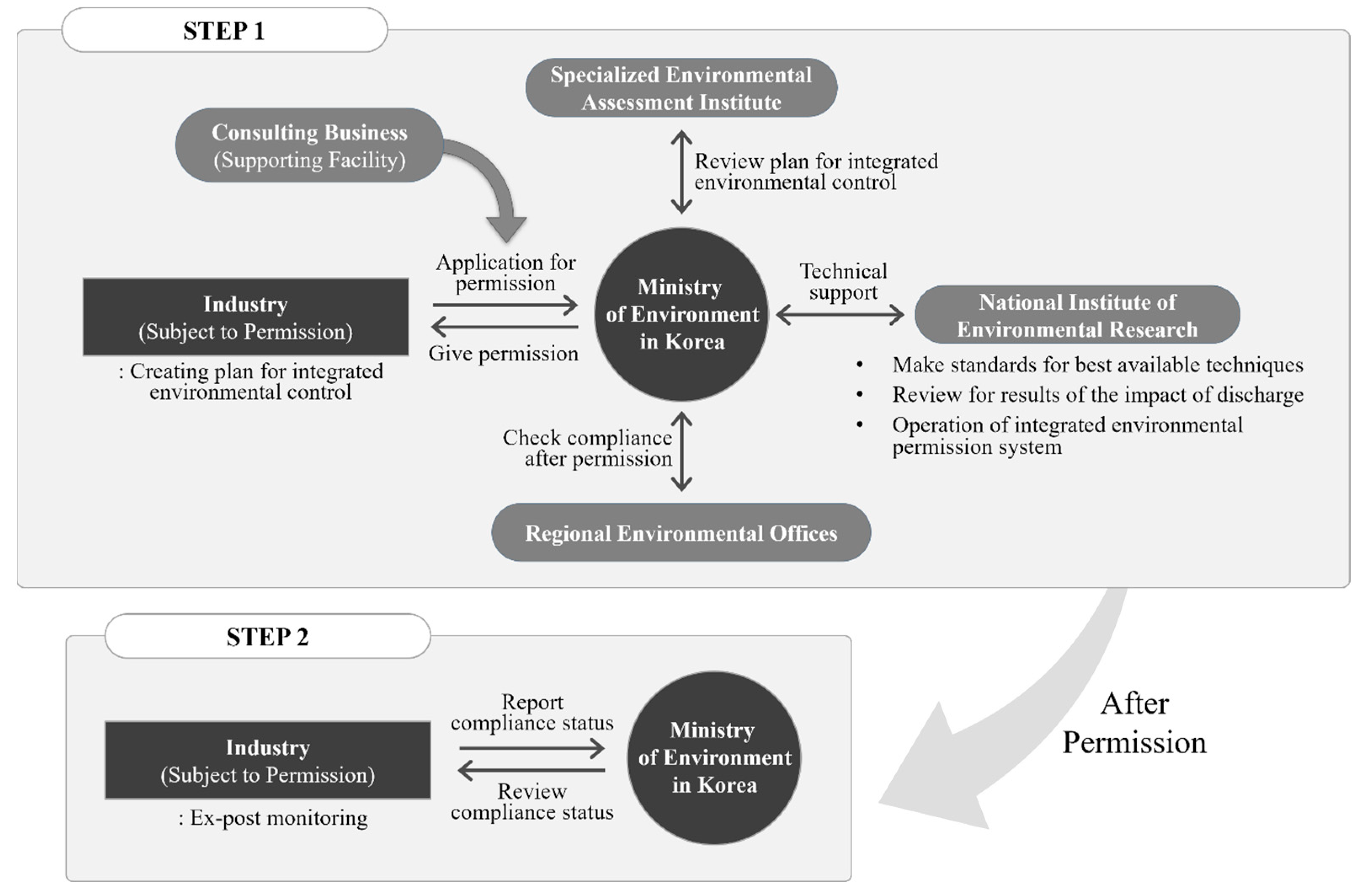
Figure 3.
Process of establishing the permitted emission standards.
Figure 3.
Process of establishing the permitted emission standards.
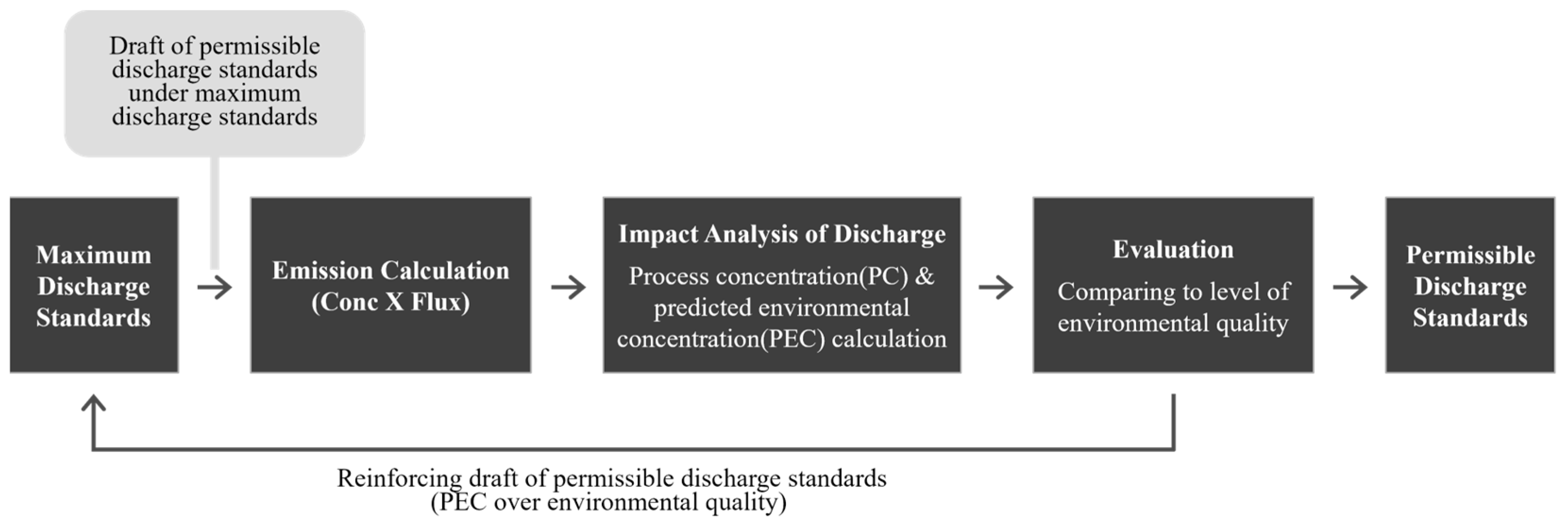
Figure 4.
Availity of standards for best available techniques.
Figure 4.
Availity of standards for best available techniques.
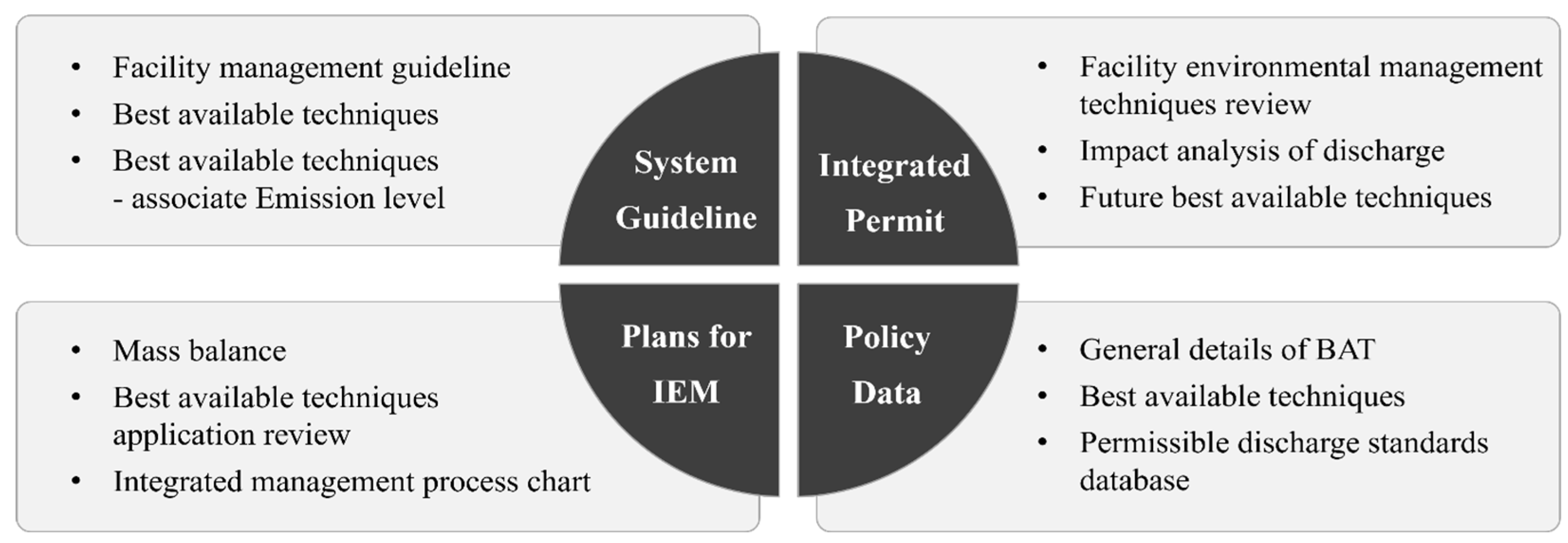
Figure 5.
Overview of integrated environment management education program at University K.
Figure 5.
Overview of integrated environment management education program at University K.
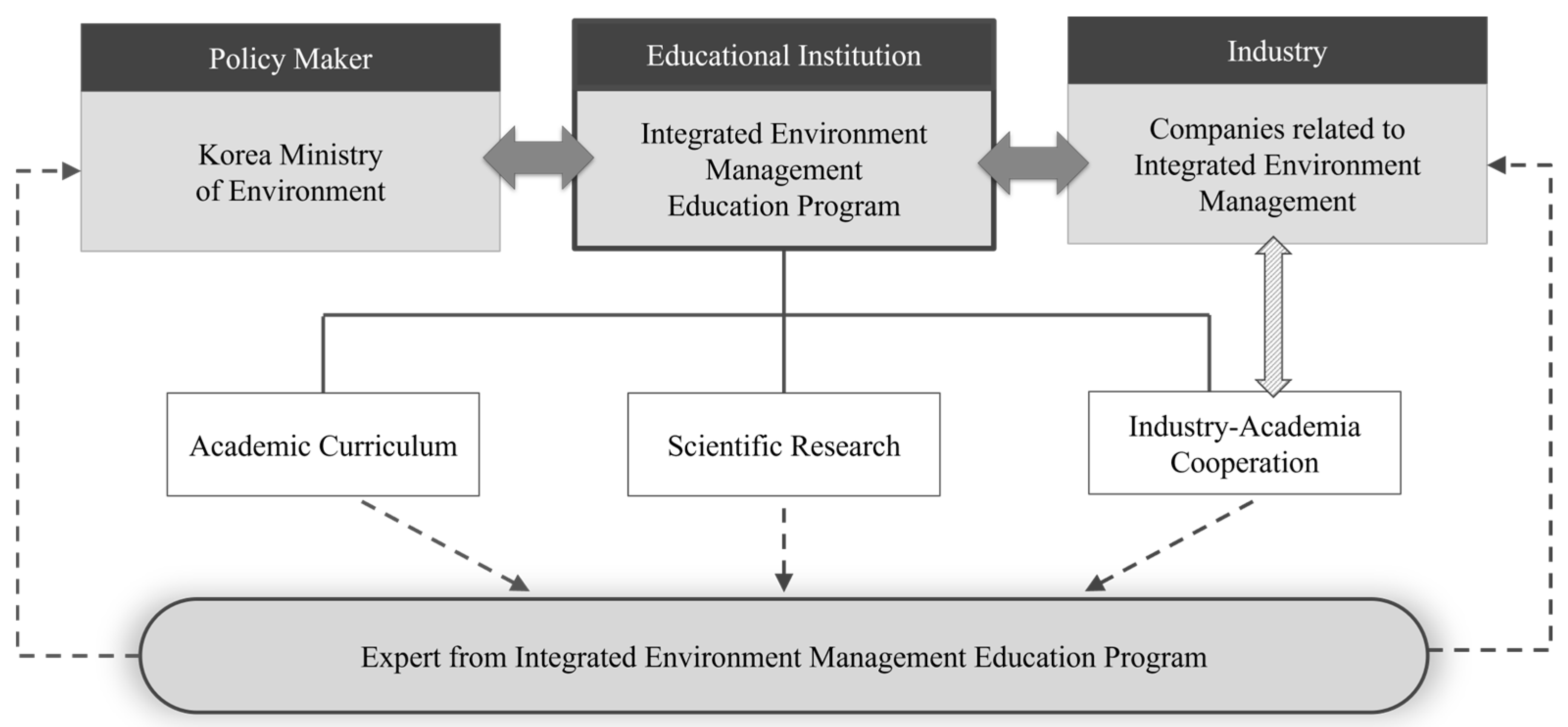
Figure 6.
Curriculum organization and process by committee.
Figure 6.
Curriculum organization and process by committee.
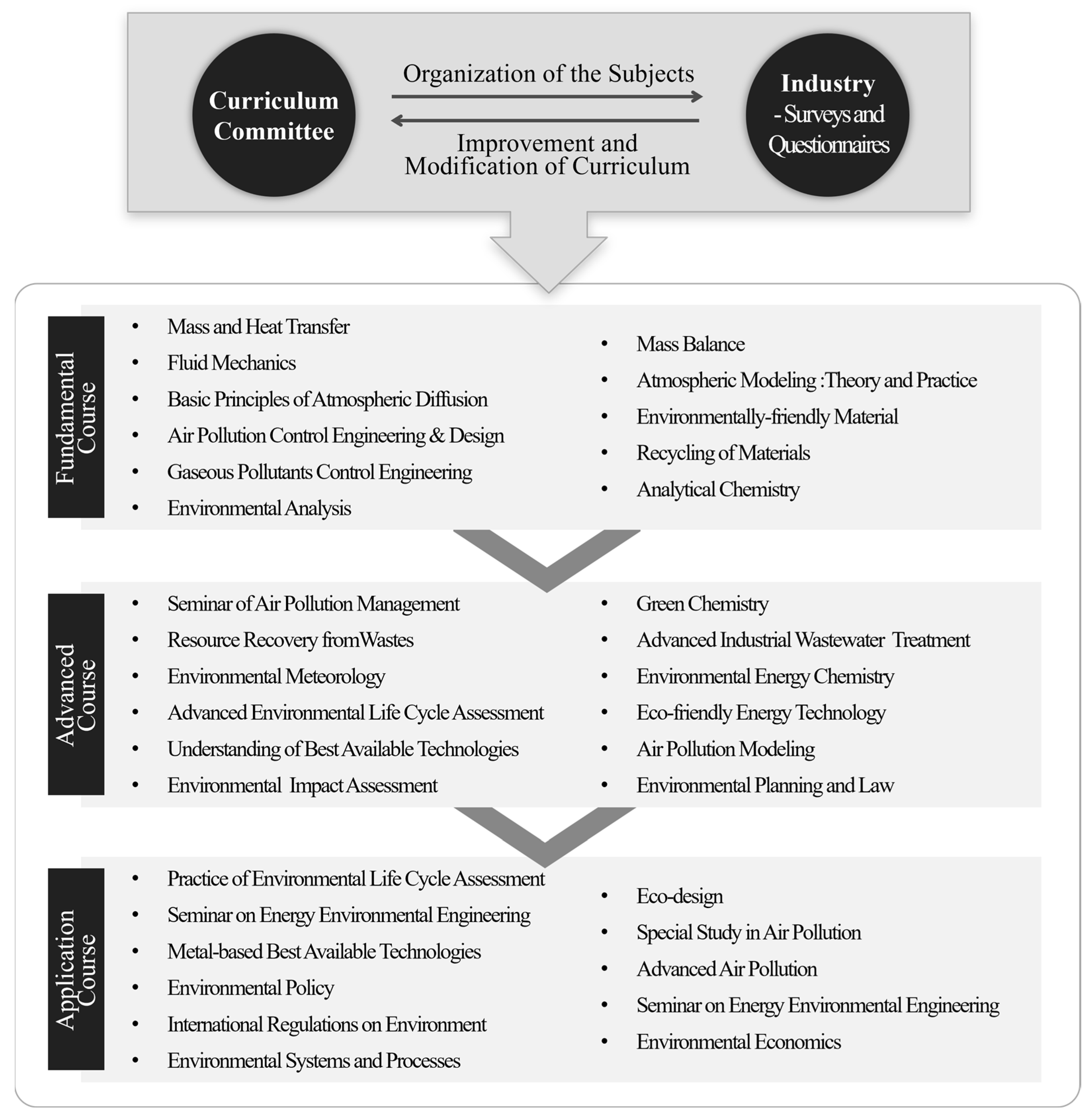
Table 1.
Survey questionnaire about the program.
Table 1.
Survey questionnaire about the program.
| Survey of Participants and Experts | Program Operation Performance |
|---|---|
|
|
|
|
|
|
|
|
|
|
Table 2.
Integrated environment management in Europe and Korea.
Table 2.
Integrated environment management in Europe and Korea.
| Europe | Korea | |
|---|---|---|
| History |
|
|
| Range |
|
|
| Integrated pollutants |
|
|
| Discharge facility management after permission |
|
|
| BAT management |
|
|
Table 3.
Main topics of industrial cooperative program.
Table 3.
Main topics of industrial cooperative program.
| Main Topic | Details |
|---|---|
| (1) Theoretical education on integrated environmental management system |
|
| (2) Basic education on integrated permit consulting duties |
|
| (3) Practical education on integrated permits |
|
| (4) Education on the ability to promote integrated permits |
|
Table 4.
Research projects in IEM program.
Table 4.
Research projects in IEM program.
| Key Topic | Summary of Research |
|---|---|
| Improvement of material balance calculation methodology based on O-LCA | The aim is to prepare an O-LCA-based material balance calculation methodology by analyzing the most basic standards dealing with product LCA, ISO 14040:2006 [35], 14044:2006 [36] and KS I ISO/TS 14072:2014 [37] as well as Guidance on Organizational Life Cycle Assessment. At workplaces that implement the integrated environmental management system, it is possible to identify the causal relationships between inputs and outputs that were not identified when dealing with individual media and to identify abnormal flows in processes and facilities. |
| Improvement of pollutant reduction technology through customized convergence technology for emission sites | The purpose is to propose and present application plans for optimal utilization techniques, which are common points of the total amount of pollutants and the integrated environmental management system. This study facilitates establishment of a comprehensive evaluation model of quantitative and qualitative evaluation factors applied for integrated environmental management by pollutant emission type. In addition, the impact assessment related to the technical excellence, environmental management performance, economic feasibility, maturity of operational and management technologies, and sociality (local feasibility) of each evaluation factor is conducted. |
| Utilization and improvement of integrated environmental permit air and water pollution impact analysis program | This is a simulation program to investigate and analyze the impact of pollutant emissions from workplaces on the surrounding environment and is used to set customized permit emission standards. It considers existing pollution levels and additional pollution levels and involves conducting research on improvement measures by identifying existing problems. |
|
Disclaimer/Publisher’s Note: The statements, opinions and data contained in all publications are solely those of the individual author(s) and contributor(s) and not of MDPI and/or the editor(s). MDPI and/or the editor(s) disclaim responsibility for any injury to people or property resulting from any ideas, methods, instructions or products referred to in the content. |
[ad_2]


